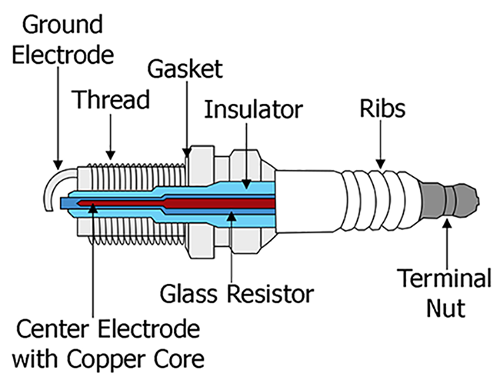In a spark ignition engine, the ignition system provides a spark that ignites the fuel-air mixture in the cylinders. This system is made up of magnetos, spark plugs, high-tension leads, and an ignition switch.
==**It is imperative to understand that the ignition system is not connected to the electrical system. A failure of the electrical system will not cause a failure of the ignition system because the two systems are independent from one another.**==
# Magnetos
The magneto uses a permanent magnet to generate an electrical current, independent of the electrical system, which generates a high enough voltage to jump a spark across the spark plug gap in each cylinder. See the video below for more information:
<div class=iframe-container><iframe width="560" height="315" src="https://www.youtube.com/embed/P5JWuYvf1Jk?si=ldLfYfmYn-1oGCHI" title="YouTube video player" frameborder="0" allow="accelerometer; autoplay; clipboard-write; encrypted-media; gyroscope; picture-in-picture; web-share" referrerpolicy="strict-origin-when-cross-origin" allowfullscreen></iframe></div>
Most aircraft have two separate magnetos, each connected to its own spark plug in each cylinder. This ensures that in the case of one magneto or spark plug failing, the engine can still operate. The firing of two spark plugs also improves combustion and results in a slightly higher power output.

Magnetos and Connection to Spark Plugs (PHAK Chapter 7)
This is the reason for the magneto check during the run up. It is imperative to check that both sets of magnetos and spark plugs are operating, and the normal drop in rpm is due to the less complete combustion from just one spark plug.
## Impulse Coupling
A mechanism that sits between the magneto's drive shaft and the engine's accessory drive. This device is used as a way to generate sufficient current for the spark plugs during engine startup. The impulse coupling intensifies the spark at slow engine speeds by using a spring loaded flyweight in one magneto which winds up and quickly accelerates to generate the proper current. It also has the effect of delaying the spark slightly so that it fires directly at top dead center, rather than slightly before during normal engine operation. See the video below for more information:
<div class=iframe-container><iframe width="560" height="315" src="https://www.youtube.com/embed/DAntiSOgh5k?si=XedUkFNG9cPqMc0x" title="YouTube video player" frameborder="0" allow="accelerometer; autoplay; clipboard-write; encrypted-media; gyroscope; picture-in-picture; web-share" referrerpolicy="strict-origin-when-cross-origin" allowfullscreen></iframe></div>
# Spark Plugs
A spark plug ignites when a high voltage is applied between the center and ground electrode, which breaks down the insulation between the electrodes and generates a spark. The magnetos provide this voltage at the correct time, which allows the fuel air mixture to ignite. High-voltage leads are what connect the spark plug to the magneto.

Spark Plug Diagram